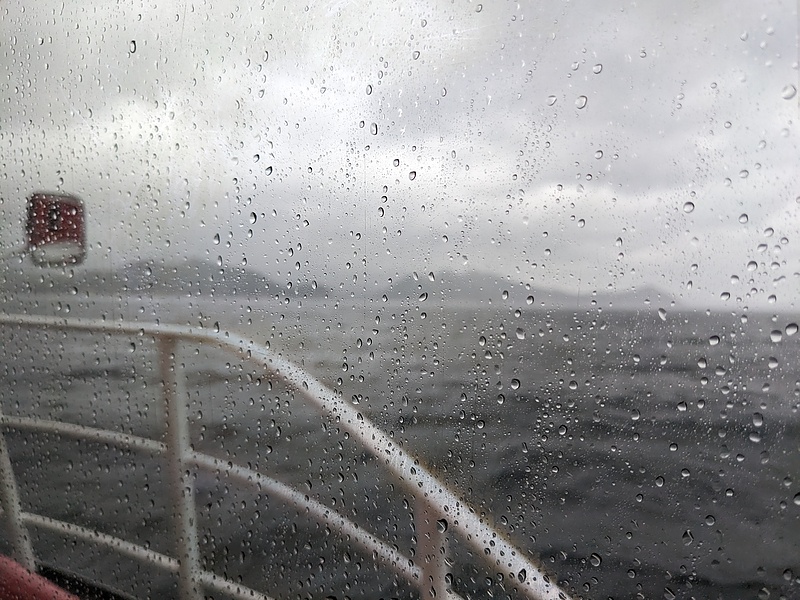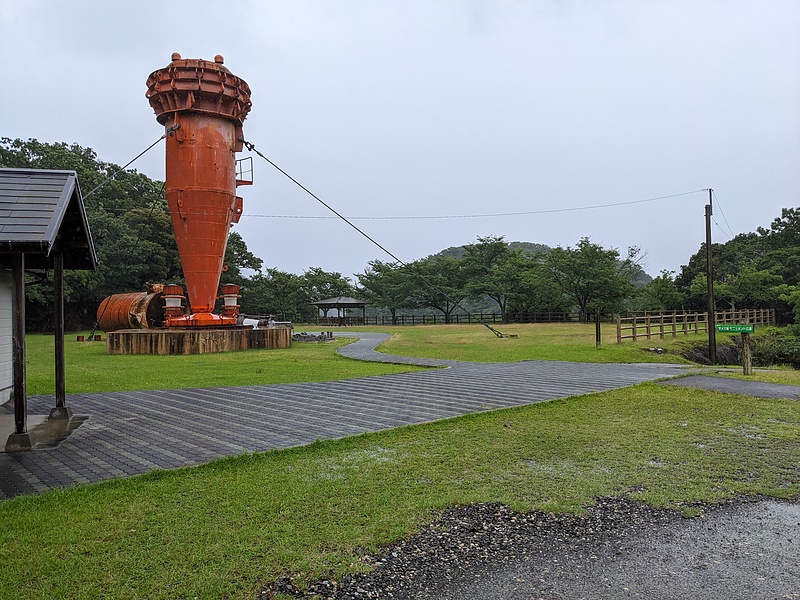IEICE technical committee meeting of Communication Systems at Tsushima, Nagasaki
The journey to Tsushima
The July conference of Technical committee meeting of Communication Systems (CS-Ken) of the Institute of Electronics, Information and Communication Engineers (IEICE) is held outside of main island of Japan as part of the Remote Island Series. The 2024 IEICE CS-Ken was held on July 11th and 12th in Tsushima, Nagasaki Prefecture.
Historically, Tsushima has played an important role in trade and cultural exchange as a border town between Japan and Korea, and also in national defense. Also, before the advent of GPS, Tsushima played a part in the Omega System, which provided position information for ships and aircraft using only radio waves, just like GPS. Currently, Tsushima is a treasure trove of flora and fauna, including the Tsushima wildcat, and is also a source of drone technology and imaging technology. Tsushima can be said to be a mecca for radio navigation and IT.
I was very fortunate to have the opportunity to give a presentation at a conference in Izuhara, the largest city on Tsushima.
This time, I headed to Izuhara Port by boat from Hakata Port, which is about a 15-minute bus ride from Hakata in Kyushu. The route between Hakata and Tsushima includes a jetfoil that travels at a maximum speed of 80 kilometers per hour and a ferry that can also carry cars.

Reservations for the Jetfoil can be made one month prior to boarding. I made a reservation in advance. Boarding procedures begin one hour prior to departure at Hakata Port and end 30 minutes prior to departure. To board, you will need to write your name on the boarding list available on-site, as well as your reservation number if you have made a reservation, and submit this to reception. All seats on the Jetfoil are reserved, and you can choose your seat if you have made a reservation in advance. The boarding pass is divided into left and right, and the right side is to be submitted when boarding and the left side when disembarking.

This is the jetfoil “Venus” that we boarded. Boarding begins 10 minutes before departure.

On the way, we anchored at Iki Island and headed to Izuhara Port. Unfortunately, it was raining at Izuhara Port.

It takes about 10 minutes on foot from Izuhara Port to reach the center of Izuhara. This is the streetscape of Izuhara and the Tsushima Communication Center, where the CS-Ken was held.

Conference of Communication Systems
This Tsushima Communication Center is attached to the shopping center “Tiara” and Max Value supermarket, and has a stage and large and small conference rooms. The large conference room was used for special invited lectures by the CS Lab and general lectures, and the small conference room was used for a poster session for students.

The main conference room had a stage and the venue was comfortable.

The poster session venue was also beautiful. There were not many people there yet as the poster session had not yet started, but it was bustling with people during the poster session.

I also gave a research presentation on the second day of the conference. The title of my presentation was “Time-variance of augmentation message contents for GNSS high precision positioning (in Japanese),” and it was about high precision satellite positioning.

There was a social gathering on the first night of the conference. We were served many Tsushima specialty dishes and ate our fill of delicious food.

This is Tsushima’s specialty dish, Ishiyaki. Fish and vegetables are dipped in the clear sauce in the center and grilled on a hot stone.

In addition to this stone-grilled dish, we enjoyed Tsushima cuisine such as sashimi, tonchan, which is pork loin marinated in soy sauce and miso, and rokubee, which is udon noodles made from sweet potato flour and served in soup. There were 43 participants in this CS-Ken (including those who only attended for one day), and I heard that there were 37 participants in the social gathering. It was a great success.
Stroll around Izuhara
I stayed at a temple lodging on a hill in the center of Izuhara. I also participated in morning Zen meditation, which was a valuable experience for me to face myself.

I had some free time the day before the conference and in the evening on the last day, so I walked around the town of Izuhara. Opposite the Tsushima Exchange Center is the Tourist Information Center Fureai Dokoro Tsushima (tourist information center).

This tourist information center has many exhibits that clearly explain the history and culture of Tsushima. Before exploring Izuhara, be sure to do some research here. You’ll come to appreciate the shrines that you might pass by without knowing about them. Free admission.

The Tsushima Museum is located right next to the Tsushima Exchange Center. It is a beautiful building and displays ancient pottery excavated on Tsushima. It also displays ancient documents that show exchanges with Korea.

Next to the Tsushima Museum is the Tsushima Korean Envoy History Museum, which uses videos and documents to explain the relationship between the Korean (Chosen) envoys and Tsushima.

About a 10-minute walk from the Tsushima Exchange Center, we will find the Nakarai Tosui Museum. Materials on Tosui Nakarai, a native of Izuhara who spoke English and Korean and was active as a journalist and novelist, are on display here. Tosui Nakarai was also a teacher of Higuchi Ichiyo, a Japan’s famous writer in the 1890s. Free admission.

Also, about a 30-minute walk in the other direction from the Tsushima Exchange Center, you will come to the remains of Tsushima Domain’s Ofune-e wharf, which was built in the 17th century during the Edo period to store domain ships.

Tsushima Omega Station Remains
Before GPS became available 24 hours a day around the world, ships used radio navigation systems called Loran (long range navigation system), Decca, and Omega to estimate their position. These consisted of high-power broadcasting stations on land and mobile stations that received the radio waves and moved around the world. These mobile stations estimated their position using a method called hyperbolic navigation, which estimated their position not from the direction of the radio waves from these stations, but from the time difference in the arrival of radio waves from multiple stations. With the spread of GPS, these systems were abandoned.
In the past, Tsushima had all of these broadcasting stations: Loran (station number ELMO 18), Decca (station number Kita-Kyushu 7C Red), and Omega (station number H). In particular, the Omega system was named after the last letter of the Greek alphabet, Omega, which represents the ultimate radio navigation system, because it covered the world with only eight stations. Since a mobile station must receive radio waves from at least three stations to perform hyperbolic navigation, the radio waves from the Tsushima Omega station must have reached at least one-third of the world. The Omega system was in operation 35 years ago when I was a university student, and was also covered in my university classes. I had been wanting to visit the Tsushima Omega station, which played a part in the safety of the world’s oceans.
The site of Tsushima Omega Station is located around Hidakatsu in the northern part of Tsushima. To get to Tsushima Omega Station from Izuhara in the southern part of Tsushima by public transport, take the Tsushima Kotsu Bus to Hidakatsu, a distance of 87.4 km, and then take a taxi from Hidakatsu. There are only five buses from Izuhara to Hidakatsu per day. It is not realistic to use public transport to visit the site of Tsushima Omega Station, so you will either have to rely on locals or rent a car yourself (about two hours one way from Izuhara).
The site of the Tsushima Omega Station has been developed as Omega Park. The 450m-tall steel tower was demolished, but part of it remains as a monument.

Inside the tower, lying on its side, there was a ladder and a safety fence.

There are also ceramic insulators that are used to insulate and maintain high voltages and currents.

The tower is coated to withstand wind, rain and salt.

There were also six insulators supporting the bottom of the Omega Station. At the time, these insulators were arranged in a hexagonal shape, and the steel tower was built on top of a disk placed on top of these insulators.

While the main transmission frequency was 10 kHz, even with such a huge antenna, the resonant frequency was only about 40 kHz, so an antenna four times longer would have been necessary. Therefore, a huge matching device was installed inside the station building to efficiently radiate radio waves. The eight Omega stations around the world were synchronized with each other using cesium atomic clocks, and in combination with two sub-transmission frequencies, each had a different 10-second period for time code transmission and distance ambiguity resolution. If the timing was right, the data required for position estimation could be obtained with just 10 seconds of radio wave reception, so it could be used not only on ships but also on airplanes. I am amazed at the enthusiasm of the engineers who solved the problems of radio wave propagation, time synchronization, radio equipment, and architecture in the 1970s, and put a huge practical system into operation. I was thrilled to see the real Tsushima Omega Station.
Conclusion
I was able to visit Tsushima for an academic conference presentation, and I am grateful to the CS-Ken secretariats for their help. I was very happy to be able to visit Tsushima, a place of history, diplomacy, culture, food, and radio navigation.